Battle of Mametz Wood 5th – 12th July 1916.
In this section of the Unit’s history, I have concentrated on the casualty evacuation chain during the Battle of Mametz Wood and especially the role played by the 130th (St John) Field Ambulance and the men who served in it. I have not attempted to describe the Battle in detail except when this helps to clarify the work of the Unit. There are a number of excellent books about the Battle itself including, Mametz, Lloyd George’s ‘Welsh Army’ at the Battle of the Somme by Colin Hughes, Mametz Wood by Michael Renshaw and Dr Jonathan Hicks’ new book, published in April 2016, entitled The Welsh at Mametz Wood – The Somme 1916, all of which are well worth reading to gain a fuller insight into the battle itself. The Battle of Mametz Wood was the baptism of fire for the 38th (Welsh) Division and saw the first fatalities of members of the 130th (St John) Field Ambulance.
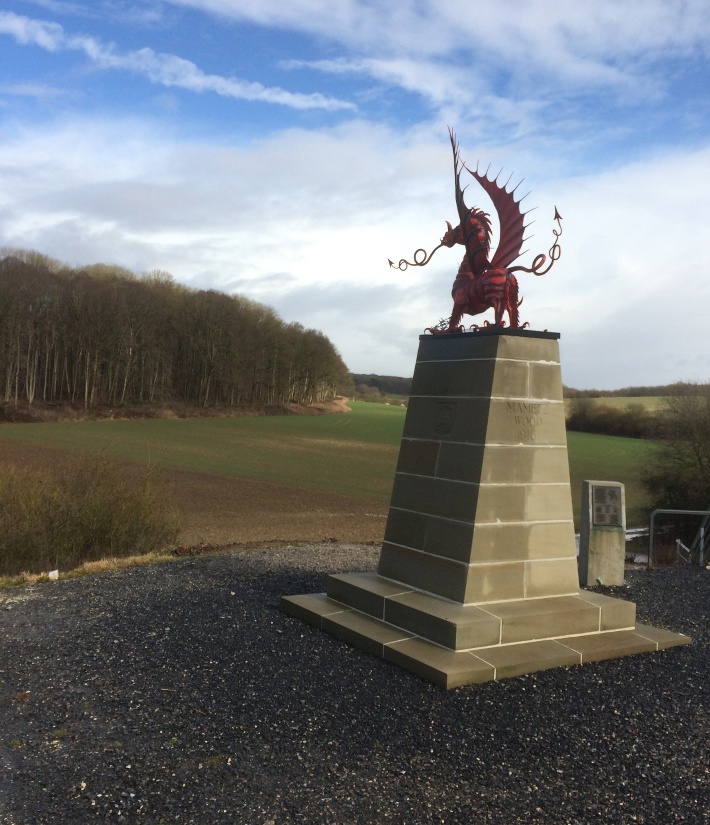
38th (Welsh) Division Memorial at Mametz Wood situated at the north end of Caterpillar Wood looking across to the Hammerhead of Mametz Wood.”
The Map below shows the situation into which the 38th (Welsh) Division were moving. The Front Line on the 1st July ran in a roughly north – south direction to the east of Albert before turning to run west – east south of Fricourt before turning to run north –south again at a point south of Montauban and it was into the area of the line running east – west that the Division was moving towards.

Extract from The Fir Tree Aerial Map of the Somme used with permission from R. A. Chandler http://www.firtreemaps.com”
****warm and sunny day records Lieut D C M Page. At 11.30am on the 5th July, Lt Col Davies attended a conference at the A.D.M.S.’s office at Treux. The three Field Ambulance units of the 38th (Welsh) Division were now no longer attached to a Brigade each but were now under the direction of the A.D.M.S..The 129th Fld Amb was to be located at Morlancourt and was tasked with treating the sick of the Division, the 130th (St John) Fld Amb was to treat the walking wounded while the 21st Fld Amb (7th Division) was to remain at Morlancourt to treat the stretcher cases. The 131st Fld. Amb., reinforced with the stretcher subdivisions of the 129th and 130th (St John) Fld. Ambs. was to be based at Minden Post.
That evening, following the A.D.M.S.’s orders, the Unit proceeded to Morlancourt to take over the M.D.S. there, situated in an old church, from the 23rd Field Ambulance, and also the A.D.S. at Citadel. Capt Ffoulkes and Lieut Elliott with a small advance party proceeded to the Citadel while Capt Anderson and Lieut Anderson along with an interpreter and cook proceeded as the advance party of the Unit to the M.D.S. at Morlancourt. 48128 Sgt Francis B Sumption also went by car with this advance party to take over the drug/medicine supply at the new M.D.S.. The three stretcher bearer subdivisions of the Unit under the command of Lieut Buckley and Lieut Page moved from Heilly at 5.15pm and Lt Col Davies, Capt Jones and Lt Burke left with one tent subdivision and the transport at 5.30pm. During their march from Heilly to Morlancourt the Unit passed many troops coming back from Monday’s battle. They were dead tired and dusty but full of beans. Many of them carried German helmets, caps and other souvenirs. They also passed a large number of German prisoners, for many in the Unit, this was their first sight of their enemies. It must be remembered that the capture of Mametz village by the 7th Division (XV Corps) and Montauban Ridge and Montauban Village to the East by the 18th and 30th Divisions (XIII Corps) was one of the rare success stories of the initial phase of the Battle of the Somme. The forward edge of the ground captured by these Divisions was to be the jumping off point for the 38th (Welsh) Division’s assault on Mametz Wood.
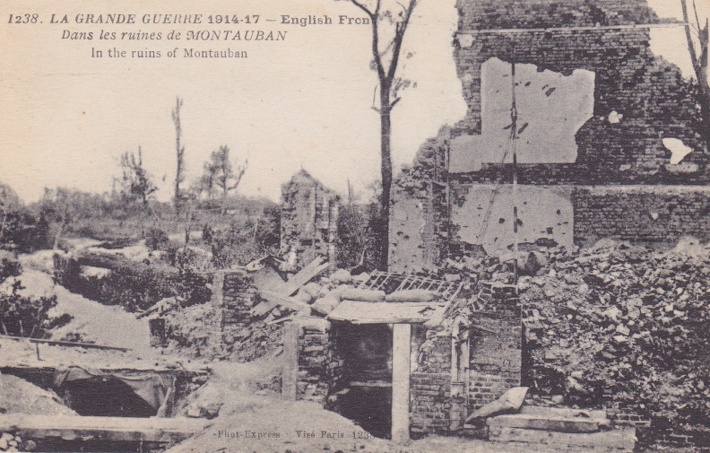
As the 23rd Fld Amb (7th Division) had not received orders to move, there were no billets for the Unit and the men spent the night in tents in a field close to the hospital. The Unit finally took over from the 23rd Field Ambulance at the A.D.S. at Citadel in the early morning of the 6th July and at the M.D.S. at Morlancourt at 9.30am. All casualties admitted by the 23rd Fld Amb except one had been evacuated prior to the take over.
The A.D.S. consisted of dug-outs built to form a good dressing room and with bunks for 20 cases. The M.D.S. at Morlancourt was in a derelict church dating from 1741. Lt Col Davies describes it as having been allowed to get into a neglected and dilapidated condition, especially the roof – a greater part of the ceiling had fallen in.

The church at Morlancourt used as the M.D.S. by the Unit during the Battle of Mametz Wood.
The church had two entrances, one on either side of the tower on the west side. The northern one was used as the entrance door for casualties, outside of which a cook house and pack store were erected. Wounded men on admission were met and their packs and steel helmets recorded and stored. They then entered the north aisle where their particulars were recorded and they sat on the pews in that aisle until their turn to be attended to. While they waited, they were fed with hot beef tea, cocoa, tea, bread and jam, butter, cheese etc. The chancel of the church was screened off and used as an operating and dispensing room. Three dressing tables were laid out, each manned by a Medical Officer and two dressers. The Sgt Dispenser on duty was in charge of anti Tetanus inoculation and marked the wrists of the patients once treated. The Vestry was used as a dispensary and a second Sgt Dispenser was posted there by day, making solutions, preparing dressings and lotions and was assisted by the carpenter of the Unit who shaped and cut splints for fractured limbs.
After having their wounds dressed, the patients passed on to the south aisle where the Staff Sgt in charge of the admissions and discharge book was posted and who took further details from the men who were then supplied with a blanket, food and cigarettes and evacuated through the door of the southern aisle or placed to lie on stretchers in the tower room.
The first casualty was admitted at 9.40am and by 9pm, a total of 36 casualties had been admitted, mostly suffering with gun shot wounds to the limbs.
The first day at the M.D.S. at Morlancourt (Thursday 6th July) is recorded by 48128 Sgt Francis B Sumption as “The hospital is in a church. The patients walk up one aisle to the dressing room which is near the altar and when they are dressed (wounds treated) they walk down the other. We are all arrayed in white gowns and I should think look very neat” (this is the first mention of the men of the Unit wearing white gowns at the M.D.S.). “The tables are piled with bandages, wool, gauze and swabs. Scissors and iodine bottles are sprinkled about and in the centre of the room are the instruments. I sharpen the needle of the A.T. (anti tetanus) syringe and see that the razors are sharp and prepare for work. The Field Ambulance before us had 1000 through in one day so we I suppose can look out for squalls. But I am used to scenes of blood so a few more won’t matter much.”
When the wounded men left the dressing room they were given cocoa or beef tea and something to eat as they were very hungry, often not having had anything to eat for a day or more. Men who had jaw or facial injuries were fed with a feeding cup.
48563 Pte Ieuan Phillips was taken off duty during the day of the 6th July and told to rest as he was going to be on night duty starting at 8pm and so he slept all day. When he came on duty he recorded that there was still a heavy bombardment going on and a great number of wounded coming down. The wounded were sleeping in the pews in front of him, “poor chaps”
The Battle of Mametz Wood consisted of two separate assaults, the first carried out by the 115th Brigade on the morning of the 7th July 1916 which proved to be a costly failure and a second assault on the 10th/11th July by the 113th and 114th Brigades with the 115th Brigade in reserve which ultimately took the wood.
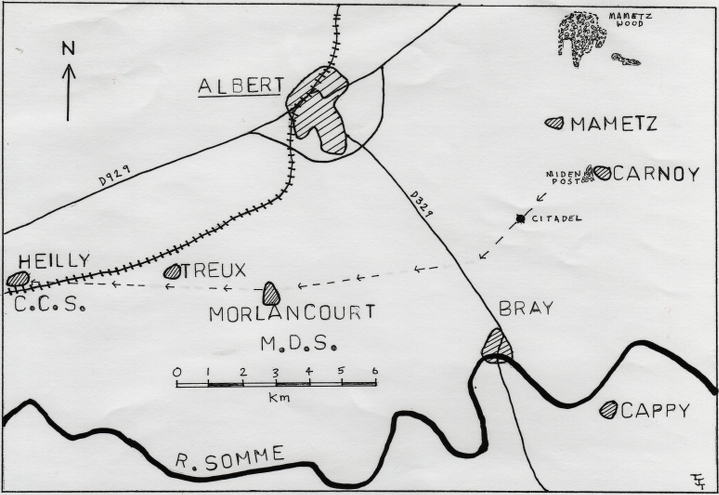
The hand drawn map above, reproduced here by kind permission of WW1 historian Trevor Tasker, nicely shows the very long journey the wounded and the stretcher bearers had to make from the battle area around Mametz wood (top right corner of map) back to even the A.D.S at Minden Post and remember this journey was across the saturated, shell torn ground of the German front and reserve lines prior to the 1st July, the old no-mans land and the old British front line trenches! It is also important to remember that the wounds caused by high velocity missiles (rifle and machine gun bullets and shrapnel), known today as high energy transfer wounds, cause temporary cavitation along the wound tract sucking in fragments of clothing, mud and other debris. Thus all such wounds were contaminated and in this pre antibiotic era, infection rapidly set in (see – https://surgeryonline.wordpress.com/tag/missile-injuries/ for more details). Furthermore, blood transfusion, a lifesaving treatment in modern trauma surgery, was in its infancy and the ability to store blood by use of sodium citrate and refrigeration had only been discovered a few years earlier and it was not until early 1917 that transfusion with stored blood was introduced at Casualty Clearing Stations.
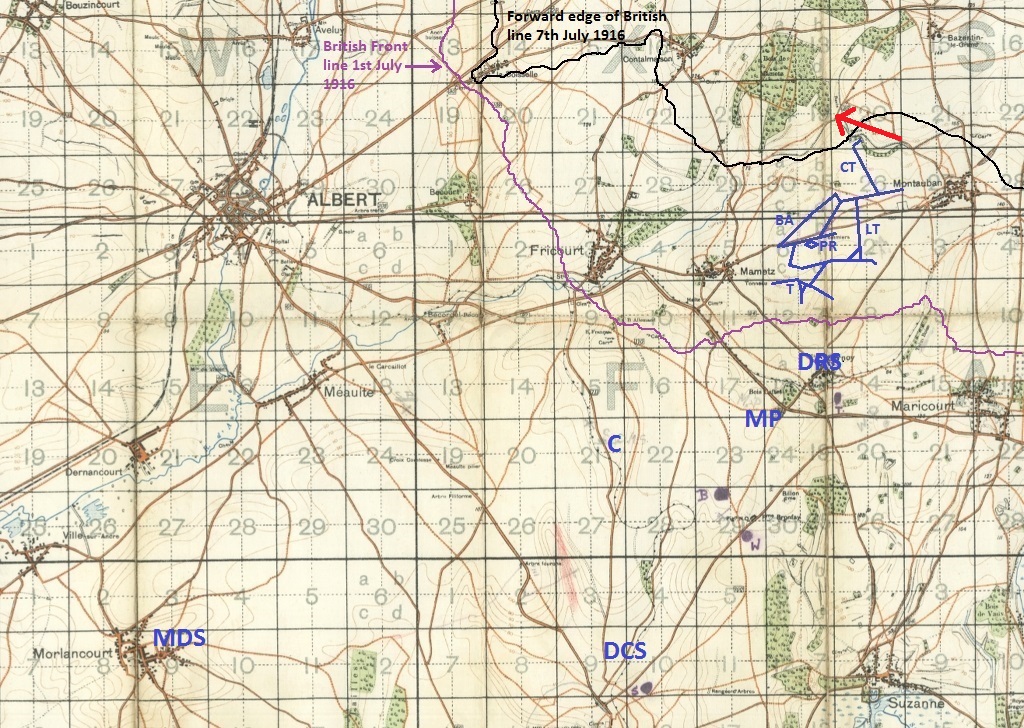
The basic plan for the medical support of the 38th (Welsh) Division’s assault on Mametz wood was that the 129th Field Ambulance would treat the sick of the Division at its M.D.S at Morlancourt, the 130th (St John) Field Ambulance would treat the walking wounded at its M.D.S. also at Morlancourt and the 21st Field Ambulance would treat the stretcher cases at Morlancourt. The 131st would man what in effect was a Divisional A.D.S. at Minden Post (MP) and be responsible for the clearing of casualties from the field of battle supported by the stretcher bearer subdivisions of the 130th (St John) Field Ambulance. The 129th Field Ambulance was also to supply Officers and men to man the Divisional Collecting Station (D.C.S.) just north of Bray and use many of its stretcher bearers to transport the wounded along a horse drawn tramline running from near Minden post, via the Citadel back to the D.C.S.. The 77th Sanitary section were to establish a Divisional Rest Station (D.R.S.) at the cross roads just north of Carnoy, known in the War Diary of the 130th (St John) Field Ambulance, but not by anyone else, as Sapper Corner).
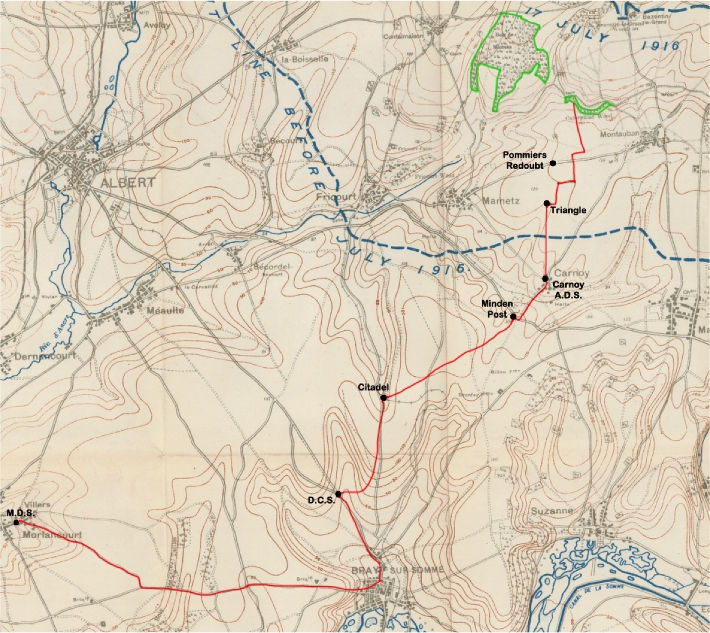
The line of the assault on the morning of the 7th July is indicated by the bold red arrow on the map, two above, and again in the photograph below.
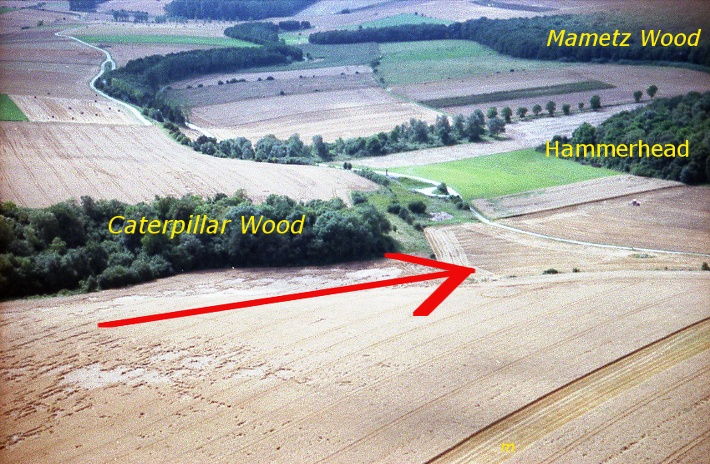
This photograph is reproduced here with the kind permission of the WW1 historian Trevor Tasker. The red arrow marks the line of assault by the 10th S.W.B. and the 16th Welsh on the 7th July 1916.
Friday 7th July was a miserable cold and wet day. The three stretcher bearer subdivisions along with four MOs were ordered to report to the OC 131st Fld Amb at Minden Post (MP). At 6am on the morning of 7th July, 2 officers (Capt Jones, and Lieut Burke) and about 70 other ranks left the HQ at Morlancourt in lorries at 6am taking with them rations, stretchers, wheeled stretchers and cooking utensils, while Lieut Page and 5 men left on foot at the same time to relieve Capt Ffoulkes and Lieut Elliott and the 30 men already at the Citadel, arriving at 7.30, where Lieut Page had to treat sick and wounded while up to his knees in liquid mud and the mess-room being flooded out. Capt Ffoulkes and Lieut Jones and the 30 men (including 48554 Pte George H Jickells) relieved at Citadel then marched to Minden Post, where they met up with Capt Jones and Lieut Burke and the 70 bearers from Mourlancourt. Capt Ffoulkes reported to the OC 131st Field Ambulance to come under his command, at 9.30. Six motor ambulances under the charge of the MT ASC Sergt of the Unit also reported to the OC 131st Fld Amb at the same time. Three horse drawn ambulances from the Unit were sent to report to the OC 129th Fld Amb at the D.C.S. north of Bray.
The OC 131st Fld Amb ordered Capt Ffoulkes to take the officers and men (of the Unit) under his command to occupy the Triangle (T) and to make contact with the RMO’s of the 11th S.W.B. and 16th W who had their aid posts in Caterpillar Trench (CT) and to assist them evacuate the wounded back to the Triangle.
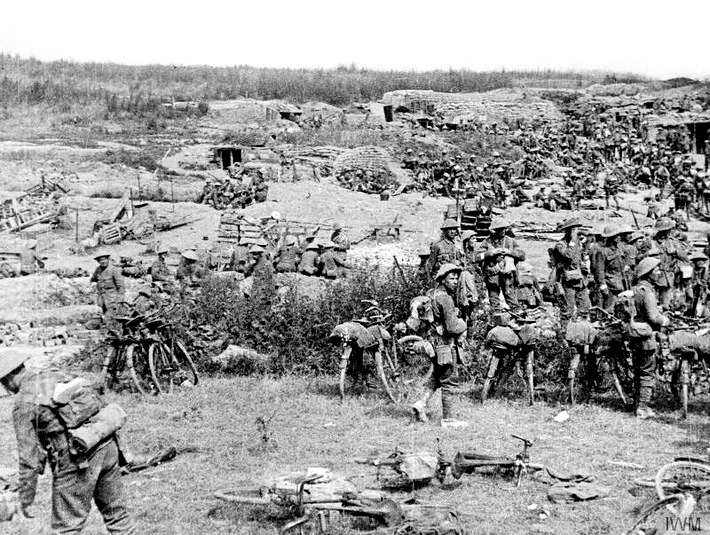
The photograph above of Minden Post during the 1st week of July 1916 is courtesy of the Imperial War Museum ©IWM(Q65417).
The various accounts of the next 24 hours or so differ in the exact number of men of the Unit allotted to various locations and precise times vary, so I have used my judgement to give the best approximation in the narrative below.
Thirty of the Unit’s bearers were left at Minden Post while the remainder were divided up into 3 parties each under a section Sgt who proceeded up to the Triangle (T), where one party along with Lt Elliott and Lt Burke were posted and all the wheeled stretches were left here. The remaining two parties under Capt Foulkes and Capt Jones along with 48124 Sgt Hopkins and 48068 Sgt Frank J King went over open ground to Loop Trench (LT) and then proceeded alone to Caterpillar Trench (CT) to the Aid Posts of the 16th Welsh and 10th SWB.
The Officers and men of the Unit assisted in dressing a large number of wounded men, and while the walking wounded were directed back along Caterpillar Trench (CT) it was too narrow and crowded with troops coming forward for stretcher cases to be evacuated and so four German dugouts were found in a protected position on the slope of Caterpillar Wood and cleaned out and used to accommodate the serious cases on stretchers. By early afternoon these dugouts were full and so other cases were cared for under bivouacs, formed from the waterproof sheets belonging to the men of the Unit.
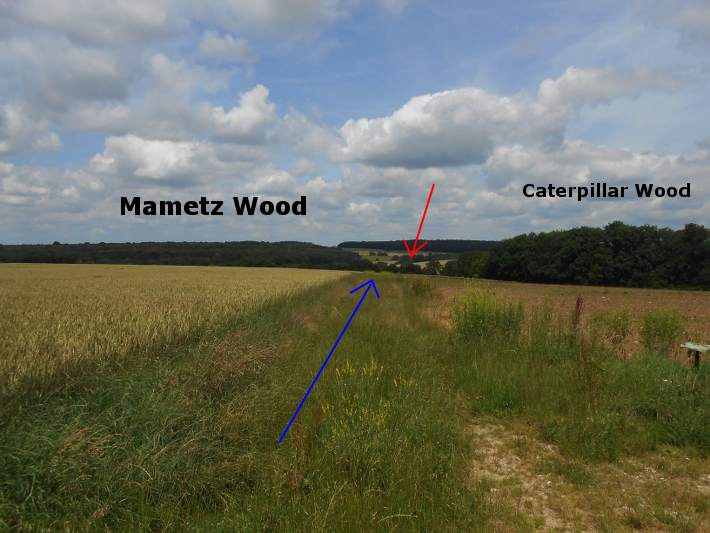
The photograph above taken in July 2016 of the course of Caterpillar Trench (blue arrow) looking towards the hollow (red arrow) where the trench met Caterpillar Wood.
By mid afternoon the need to find a way to evacuate the stretcher cases had become serious and Capt Ffoulkes called the section Sergeants together and explained that a way needed to be found. 48124 Sgt Thomas G Hopkins and 48068 Sgt Frank J King discovered a path through the bushes, parallel with Caterpillar Trench and so, the two Sergeants and 20 men began to evacuate 5 stretcher cases at a time, initially over open ground on the right of the narrow trench, along the path through the bushes parallel with Caterpillar Trench up a gradient all the way, meaning that the men were exposed to enemy fire necessitating them to get back into Caterpillar Trench for 300-400 yards before going up back over open ground again to Loop Trench (LP) to the Triangle and then again over open ground to the Triangle (T) a distance of about 3 miles!
On a second trip back with stretcher cases, while crossing the open ground between Caterpillar and Loop Trenches, a shell struck 48217 LCpl William J West, blowing off his head, and fragments of the shell also wounded 48147 Pte William E Jones and 48067 Sgt Henry J Hill. 48554 Pte. George H Jickells records ” LCpl West was killed by one of our shells falling short.” and later records “By jove we were lucky in not losing nearly all the lot of us – up there it was like Hell let loose.”
In the early evening, Capt Ffoulkes and Capt Jones led a party of walking wounded all the way back to Minden Post and reported to the A.D.M.S. who was there and obtained additional stretcher bearers and the two Captains then returned to the Triangle where they remained throughout the night, dressing the wounded and directing the stretcher bearers but due to the sodden ground and heavy shell and machine gun fire of the enemy, it was impossible to move all the wounded from Caterpillar Wood. The stretcher bearers of the Unit brought cases back from Caterpillar Wood to the Triangle while the bearers of the 77th Sanitary Section carried them from there back to Minden Post.
Back at the M.D.S. at Morlancourt, a total of 96 casualties were admitted between 6am and 9pm on the 7th July and where necessary after being treated and having their wounds dressed, were evacuated to 36 C.C.S. at Heilly. 48128 Sgt Francis B Sumption records that “Rain out here means hell. The fellows are covered with mud, drenched to the skin and provisions are difficult to get up. It is a dreadful sight to see them being brought in here covered in mud, but the thought of Blighty takes off the edge. When they have been dressed and fed they fall asleep in all sorts of positions. Our hospital is in a church and when it is fine the fellows stretch out in the churchyard, on the grass and on tombstones, anywhere where they can lay their heads in fact.”
During the day, 5 reinforcements reported for duty (106388 Pte J L Warn, 27937 Pte L Wix, 80512 Pte P Williams, 80232 Pte W G Webb and 80723 Pte S H Wilson) and in the evening they were sent up under 48077 LCpl Henry Arnold to the OC 131st Field Ambulance at Minden Post to assist.
At daylight on the 8th July, the men buried 48217 LCpl William J West in a hollow in the ground 40 yards to the right of Caterpillar trench and marked the site with a cross on which they had written his regimental number, rank, name, and Unit.
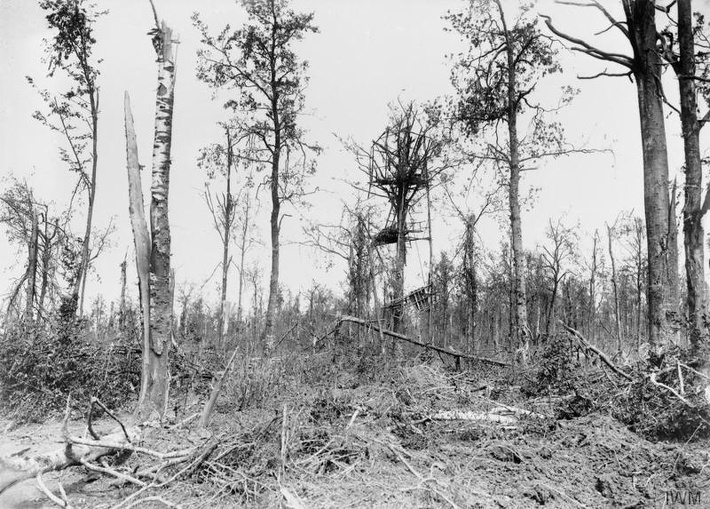
At 6am on the 8th July, with help from men of the 129th and 131st Fld Ambs, 48124 Sgt Thomas G Hopkins and his party evacuated a further 11 stretcher cases form Caterpillar Wood over open ground but immediately the first squad got into the open, 56231 Pte William Houston was shot by a sniper in the left eye. 48119 Pte George Groves recorded in his diary that he was talking to 56231 Pte William Houston when he was shot! The men dressed his wound and took him back to the 16th Welsh Aid Post where the MO redressed his wound and the men started to carry him back along Caterpillar trench, with the stretcher held over their heads because it was so narrow, but he died while being evacuated and they had to bury him in a shell hole on the side of the trench as there was a very severe bombardment taking place and many wounded for them to attend to in the trench they were in.
The 8th July saw a lull in the fighting by the 38th (Welsh) division but never the less a total of 119 casualties were admitted to the M.D.S. between 9pm on the 7th to 9pm on the 8th July. Even so, 48128 Sgt Francis B Sumption records that they prepared for the rush that they knew was coming. “All the tables are set out properly, pads of cotton wool are cut, swabs are prepared also gauze. We now use plain white gauze dipped in a preparation called Eusol (Edinburgh University solution of lime which I can well remember using when I was a junior doctor not that many years ago). ‘It is a preparation made from chlorinated lime and acid Boric and is said to be the best thing for preventing sepsis.”
At 9am on Saturday 8th July, Capt Ffoulkes and the other officers and men of the Unit were relieved by an Officer and men of the 131st Fld Amb leaving 3 bearers of the Unit to act as guides to the infantry detailed to clear Caterpillar Wood. One party of the Unit under Capt Jones returned to Morlancourt in lorries while the other, under Capt Ffoulkes, returned to Citadel arriving at 5pm.
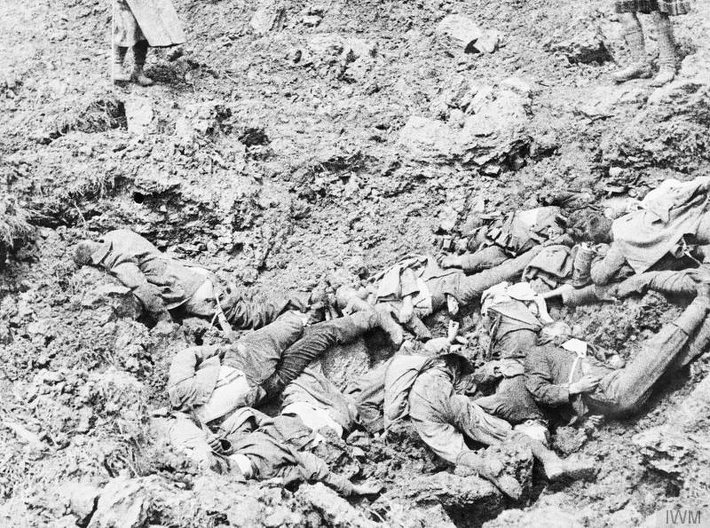
During the day, Lieut D C M Page records that the Unit’s popular Roman Catholic Padre, Father Brown came up to Citadel and the two of them went over part of the ground where the fighting had occurred earlier in the week, inspecting the old British trenches and the German frontline trenches. “The harm wrought was terrific. The whole countryside was scarred with shellholes, large and small. No man’s land was full of large craters and the German trenches were battered to pieces. The stench was awful, and the shell-holes were full of blood-stained water. There were still many German dead lying about – a pitiful sight.”
Due to the failure of the Division’s assault on Mametz Wood on the 7th July, Maj Gen Ivor Phillips was removed from his command on the 9th July and sent home and the 38th (Welsh) Division was temporarily placed under the command of Maj Gen Watts who immediately set about planning a full assault on Mametz Wood by the Division to commence the next day.
Between 9pm on the 8th and 9pm on the 9th July there were a total of 67 casualties admitted to the M.D.S. at Morlancourt. After little over 24 hours back at the M.D.S. the stretcher bearer sub-divisions were off again. At 9pm on the 9th, Capt Anderson, Lieut Anderson and Lieut Buckley with 69 other ranks left Mornalcourt and proceeded to Minden post where Capt Ffoulkes, Lieut Page and 5 other ranks from the Citadel also reported at 10pm. Capt Anderson was instructed to collect the wounded from the 114th Brigade who at 3.50am the following morning were making an attack on the front of Mametz Wood.
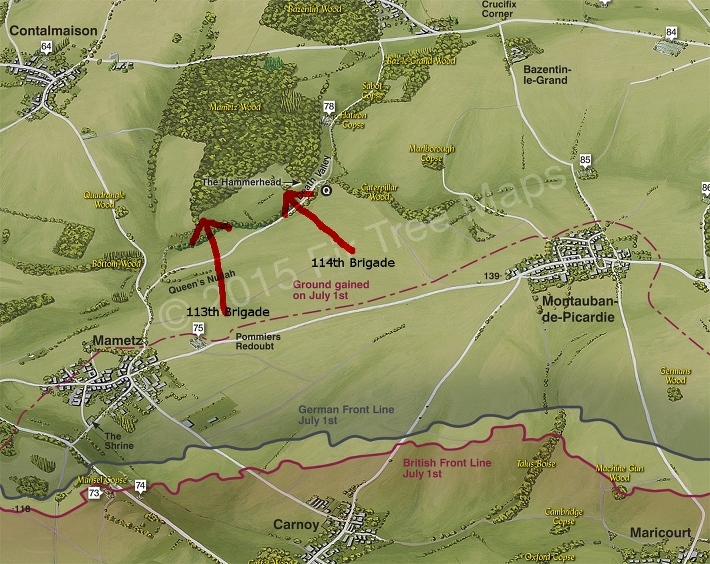
Aerial Map of the Somme used with permission from R. A. Chandler “http://www.firtreemaps.com” with lines of advance arrows added by website author.
During the assault on Mametz Wood on the 10th July, the stretcher bearers of the 130th (St John) Field Ambulance were to collect casualties from the 114th Brigade while those of the 131st Field Ambulance were to do the same for the 113th Brigade. The rendezvous for the stretcher bearers of the 130th (St John) Field Ambulance was at the cross roads at the north end of Carnoy (known in the war diary of the Unit as Sapper Corner) where the 77th Sanitary Section had established a Divisional Rest Station where they were to take up position at 3am on the 10th July. From Sapper Corner, all the officers and bearers of the Unit proceeded to the Triangle where Capt. Page with 12 bearers were posted to act as a relay. Orders were received at 3.40am from the A.D.M.S. for one M.O. and 10 bearers to report to the 114th Brigade HQ at Pommiers Redoubt and Lieut Buckley was detailed with these bearers. Also at 3.40am, Capt Anderson detailed 1 NCO and 6 bearers to report to Capt Roberts, the MO of the 10th Welsh (1st Rhondda Batt) at his Aid Post near Beetle Alley (an old German trench just to the north of Pommiers Redoubt). There was some initial confusion as to the location of the Aid Posts of the 14th and 15th Welsh, which were initially thought to be in Caterpillar Trench but were actually located near Beetle Alley but eventually the Aid Posts of all the battalions of the 114th Brigade were located and supplemented with additional bearers from the Unit.
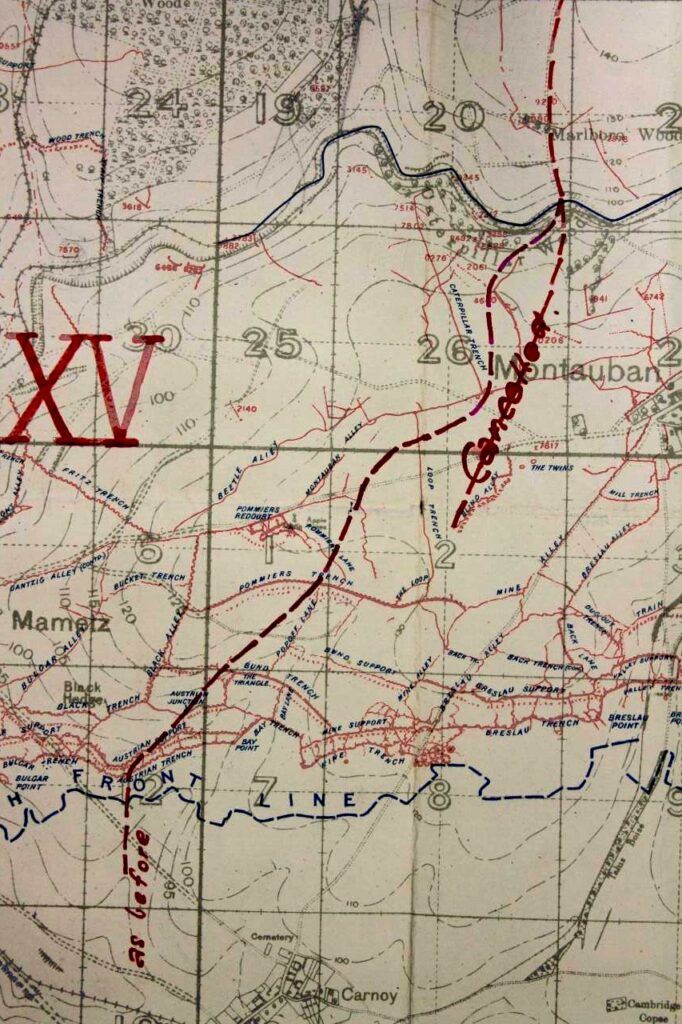
At 5am, Lieut Buckley reported that he had established an Aid Post close to Pommiers Redoubt, but due to the large number of wounded passing his post that had not come via an Aid Post, he required additional dressings, rations and water and these supplies were immediately sent up to him from the Triangle. Due to the large number of casualties, both Capt Ffoulkes and Lieut Anderson were kept busy assisting the MOs of the 10th, 14th and 15th Welsh and regulating the distribution of the bearers in their forward area while Capt Anderson maintained overall command of the bearers of the Unit.
The OC of the Unit (Lt Col Davies) rode over to the ADS at Minden Post at 6.30am on the 10th July and found things very lively with a large number of wounded officers and men awaiting attention including a number of Germans. Here, along with Maj Davies of the 131st Fld Amb he dressed a large number of the most serious cases including Lt Col P E Ricketts of the 10th Welsh. As he had only left 2 MOs back at Morlancourt, one of whom had been up all night, he returned from Minden Post at 2.30pm.
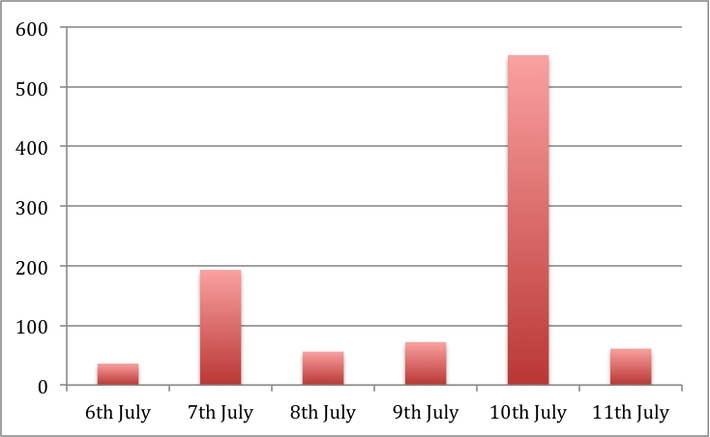
130th (St John) Field Ambulance M.D.S. admissions 6th – 12th July 1916
The chart above shows the number of admissions to the M.D.S. at Morlancourt by 24 hour periods commencing at 9.00am on the 6th July. It was during the busiest day, the 10th July that the M.D.S. was manned by only two Medical Officers and approximately 60 other ranks (the nursing sub-divisions) for much of the time.
At 8am, Capt Anderson applied to the OC 131st Fld Amb for extra bearers as there were already 52 stretcher cases laying at the Triangle awaiting removal back to the ADS (Minden Post). This message was sent back in error to the 130th at Morlancourt where it was received by Capt Jones as the OC (Lt Col Davies) was at the time assisting at Minden Post. Capt Jones immediately paraded every man of those few left at the Unit’s HQ at Morlancourt and asked for volunteers to go forward to assist Capt Anderson. Every single man volunteered including those who had been up all the previous night dressing wounded. Capt Jones selected 31 of those most fit and sent them up to Minden Post in empty ambulances and lorries from where they were sent forward to the Triangle.
At 12.30pm, Capt Williams (OC 77th Sanitary Section) offered further assistance to Capt Anderson and sent up 6 bearers to work between the Triangle and Sapper Corner. At 2pm, an officer from the 142nd Fld Amb whose advanced bearer post was situated in a dugout near the Triangle reported to Capt Anderson and offered to lend 39 stretchers and a compliment of bearers. These were employed to carry cases from the Triangle to Sapper Corner and rendered excellent service between 2pm and 5pm when they were withdrawn.
At 3.30pm 20 Army Service Corp (A.S.C.) Horse Transport men from the 131st Fld Amb reported to the Traingle and acted as stretcher bearers and worked until between 8-9pm that evening. The additional help supplied by the 77th Sanitary Section, 142nd Fld Amb and the ASC HT men of the 131st Fld Amb allowed Capt Anderson to rest about half (50) of the Units stretcher bearers for 3 hours.
Capt Ffoulkes and Lieut Anderson reported back at the Triangle at 4.30pm having been on duty at the Aid Posts of the 10th, 13th, 14th and 15th Welsh and the 19th Pioneers since the early hours of the morning and relieved Capt Anderson and Lieut Page, who moved back to Sapper Corner. Capt Anderson and Lieut Page then relieved Capt Ffoulkes and Lieut Anderson at 6pm until 12midnight allowing them to rest back at Sapper Corner. They then took over at the Triangle at midnight unit 4am on the 11th July.
Back at the Unit’s HQ at Morlancourt a total of 463 casualties were admitted between 9pm on the 9th July and 9pm on the 10th.
Having taken over again at the Triangle at 4am on the 11th July, Capt Anderson found the men of the Unit becoming utterly exhausted and reported to both the ADMS and the OC 131st Fld Amb to see if any assistance could be obtained but none was available so they were obliged to carry on until 5pm.
By 11am, information was received at the Triangle that all the cases from the Aid Post of the 14th Welsh had been cleared and only seven cases remained at the Aid Post of the 13th Welsh. By 4pm all the Battalion Aid Posts had been cleared of stretcher cases but there were reported still to be 45-50 stretcher cases at the Aid Post of the 19th (Pioneer) Welsh, in an isolated portion of the dugouts north of Caterpillar trench, with out water, rations and dressings, which could not be cleared due to heavy shelling.
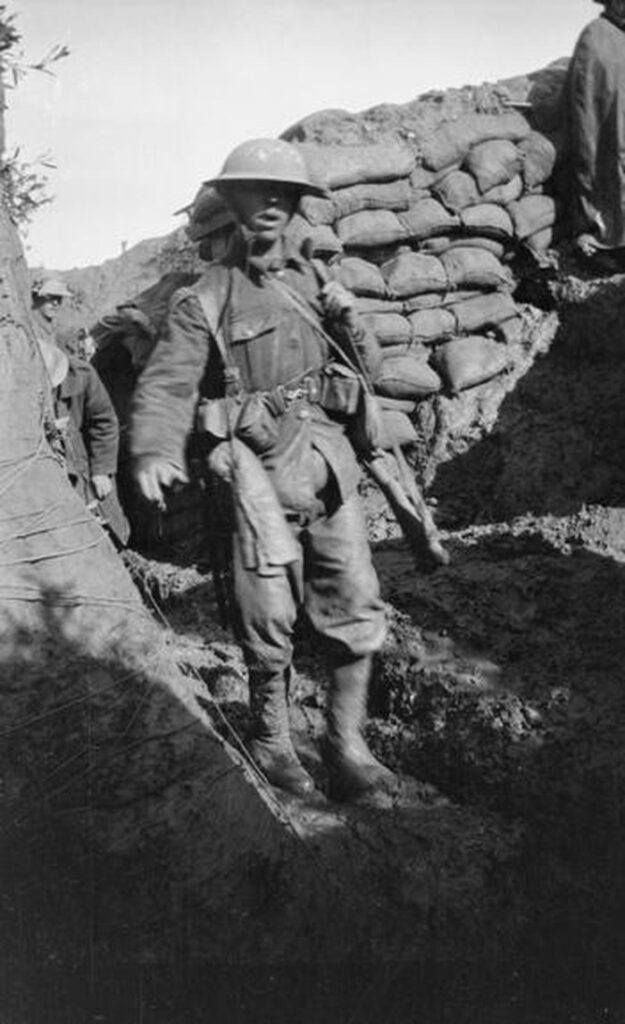
The image above is by kind permission of http://www.iwm.org.uk/collections/item/object/205278750″ Imperial War Museum collection and shows a slightly wounded man returning via Pommier Redoubt after the attack on Mametz Wood on the 7th July 1916.
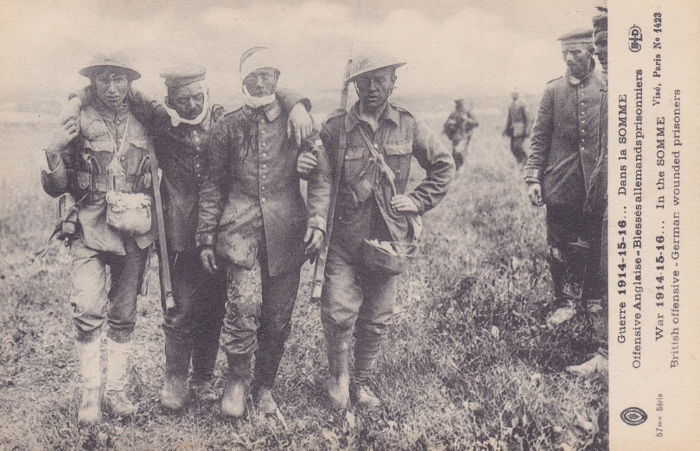
The stretcher bearer sub-divisions of the 130th (St John) Field Ambulance were finally relieved during the evening of the 11th July and returned exhausted to the M.D.S. at Morlancourt. The M.D.S. was taken over by 23rd Field ambulance at 9am on Wednesday 12th July and the transport of the Unit, under the command of Capt Jones was ordered to proceed by road while the nursing sub-divisions of the Unit marched out of Morlancourt at 4.30pm to Edge-Hill station where they entrained at 6.30pm. The officers and men all crowded into horse boxes and set off for Longpre. The stretcher bearer sub-divisions (105 men) along with Capt Ffoulkes, Lieuts Anderson, Buckley and Page were order to rest at Morlancourt and follow the Unit on foot the following day but they did not manage to rejoin the rest of the Unit until evening of the 15th July but more of this in the next section (Recovery after Mametz Wood Jul – August 1916).
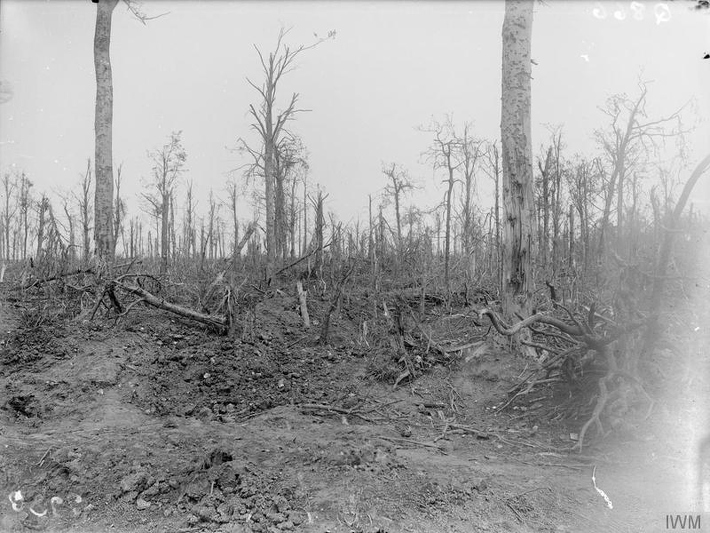

Be the first to comment